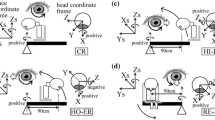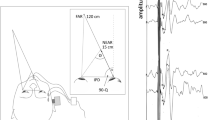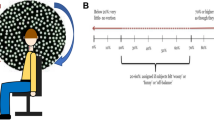Abstract
The purpose of this study was to examine the effect of fixation target distance on the human vestibuloocular reflex (VOR) during eccentric rotation in pitch. Such rotation induces both angular and linear acceleration. Eight normal subjects viewed earth-fixed targets that were either remote or near to the eyes during wholebody rotation about an earth-horizontal axis that was either oculocentric or 15 cm posterior (eccentric) to the eyes. Eye and head movements were recorded using magnetic search coils. Using a servomotor-driven chair, passive whole-body rotations were delivered as trains of single-frequency sinusoids at frequencies from 0.8 to 2.0 Hz and as pseudorandom impulses of acceleration. In the light, the visually enhanced VOR (VVOR) was recorded while subjects were asked to fixate targets at one of several distances. In darkness, subjects were asked to remember targets that had been viewed immediately prior to the rotation. In order to eliminate slip of the retinal image of a near target when the axis of rotation of the head is posterior to the eyes, the ideal gain (compensatory eye velocity divided by head velocity) of the VVOR and VOR must exceed 1.0. Both the VOR and VVOR were found to have significantly enhanced gains during sinusoidal and pseudorandom impulses of rotation (P<0.05). Enhancement of VVOR gain was greatest at low frequencies of head rotation and decreased with increasing frequency. However, enhanced VOR gain only slightly exceeded 1.0, and VVOR gain enhancement was significantly lower than the expected ideal values for the stimulus conditions employed (P<0.05). During oculocentric rotations with near targets, both the VOR and VVOR tended to exhibit small phase leads that increased with rotational frequency. In contrast, during eccentric rotations with near targets, there were small phase lags that increased with frequency. Visual tracking contributes during ocular compensatory responses to sustained head rotation, although the latency of visual tracking reflexes exceeds 100 ms. In order to study initial vestibular responses prior to modification by visual tracking, we presented impulses of head acceleration in pseudorandom sequence of initial positions and directions, and evaluated the ocular response in the epoch from 25 to 80 ms after movement onset. As with sinusoidal rotations, pseudorandom eccentric head rotation in the presence of a near, earth-fixed target was associated with enhancement of VVOR and VOR gains in the interval from 25 to 80 ms from movement onset. Despite the inability of visual tracking to contribute to these responses, VVOR gain significantly exceeded VOR gain for pseudorandom accelerations. This gain enhancement indicates that target distance and linear motion of the head are considered by the human ocular motor system in adjustment of performance of the early VOR, prior to a contribution by visual following reflexes. Vergence was appropriate to target distance during all VVOR rotations, but varied during VOR rotations with remembered targets. For the 3-m target distance, vergence during the VOR was stable over each entire trial but slightly exceeded the ideal value. For the 0.1-m near target, instantaneous vergence during the VOR typically declined gradually in a manner not corresponding to the time course of instantaneous VOR gain change; mean vergence over entire trials ranged from 60 to 90% of ideal, corresponding to target distances for which ideal gain would be much higher than actually observed. These findings suggest a dissociation between vergence and VOR gain during eccentric rotation with near targets in the frequency range from 0.8 to 2.0 Hz.
Similar content being viewed by others
References
Baker JF, Perlmutter SI, Peterson BW, Rude SA, Robinson PR (1987) Simultaneous opposing adaptive changes in cat vestibulo-ocular reflex direction for two body orientations. Exp Brain Res 69:220–224
Baloh RW, Honrubia V, Yee RD, Jacobson K (1986) Vertical visual-vestibular interaction in normal human subjects. Exp Brain Res 64:400–6
Barratt H, Bronstein AM, Gresty MA (1988) Testing the vestibulo-ocular reflexes: abnormalities of the otolith contribution in patients with neuro-otological disease. I Neurol Neurosurg Psychiatry 50:1029–1035
Bronstein AM, Gresty MA (1988) Short latency compensatory eye movement responses to transient linear head acceleration: a specific function of the otolith-ocular reflex. Exp Brain Res 71:406–410
Busettini C, Miles FA, Schwarz U (1991) Ocular responses to translation and their dependence on viewing distance. II. Motion of the scene. J Neurophysiol 66:865–78
Busettini C, Miles FA, Carl JR (1994) Human ocular responses to translation of the observer and of the scene: dependence on viewing distance. Exp Brain Res 100:484–494
Carl JR, Gellman RS (1987) Human smooth pursuit: stimulus-dependent responses. J Neurophysiol 57:1446–1463
Collewijn H, Mark F van der, Jansen TC (1975) Precise recording of human eye movements. Vision Res 15:447–450
Correia MJ, Perachio AA, Eden AR (1985) The monkey vertical vestibuloocular response: a frequency domain study. J Neurophysiol 54:532–548
Crane BT, Viirre ES, Demer JL (1995) Effect of target distance and eccentric rotation on human horizontal vestibulo-ocular reflex (VOR). Soc Neurosci Abstr 21:519
Demer JL (1992) Mechanisms of human vertical visual-vestibular interaction. J Neurophysiol 68:2128–2146
Demer JL (1994) Effect of aging on vertical visual tracking and visual-vestibular interaction. I Vestibular Res 4:355–370
Fuchs AF, Robinson DA (1966) A method for measuring horizontal and vertical eye movement chronically in the monkey. J Appl Physiol 21:1068–70
Gizzi M, Wang W (1994) Convergence suppression of the vestibulo-ocular reflex. Soc Neurosci Abstr 20:568
Goldberg JM, Fernandez C (1975) Responses of peripheral vestibular neurons to angular and linear accelerations in the squirrel monkey. Acta Otolaryngol 80:101–110
Goodale MA, Milner AD, Iakobson LS, Carey DP (1991) A neurological dissociation between perceiving objects and grasping them (see comments). Nature 349:154–6
Halmagyi GM, Curthoys IS, Cremer PD, Henderson CJ, Todd MJ, Staples MI, D'Cruz DM (1990) The human horizontal vestibulo-ocular reflex in response to high-acceleration stimulation before and after unilateral vestibular neurectomy. Exp Brain Res 81:479–490
Hine T, Thorn F (1987) Compensatory eye movements during active head rotation for near targets: effects of imagination, rapid head oscillation and vergence. Vision Res 27:1639–1657
Johnston JL, Sharpe JA (1994) The initial vestibulo-ocular reflex and its visual enhancement and cancellation in humans. Exp Brain Res 99:302–308
Lisberger SG (1990) Visual tracking in monkeys: evidence for short-latency suppression of the vestibuloocular reflex. J Neurophysiol 63:676–88
Maas EF, Huebner WP, Seidman SH, Leigh RJ (1989) Behavior of human horizontal vestibulo-ocular reflex in response to highacceleration stimuli. Brain Res 499:153–6
Noorden GK von (1990). Binocular vision and ocular motility: theory and management of strabismus. Mosby, St. Louis
Paige GD (1989) The influence of target distance on eye movement responses during vertical linear motion. Exp Brain Res 77:585–593
Paige GD, Tomko DL (1991) Eye movement responses to linear head motion in the squirrel monkey. II. Visual-vestibular interactions and kinematic considerations. I Neurophysiol. 65:1183–1196
Paige GD, Barnes GR, Telford L, Seidman SH (1996) The influence of sensori-motor context on the linear vestibulo-ocular reflex. In: Highstein SM, Cohen B, Büttner-Ennever JA (eds) New directions in vestibular research. New York Academy of Sciences, New York, pp 322–331
Rashbass C, Westheimer G (1961) Disjunctive eye movements. I Physiol (Lond) 159:339–360
Remmel RS (1984) An inexpensive eye movement monitor using the scierai search coil technique. IEEE Trans Biomed Eng 31:388–390
Remmel R (1994) Electromagnetic eye movement monitors: limits of sensitivity. In: Fuchs AF, Brandt T, Buttner U, Zee D (eds) Contemporary ocular motor and vestibular research: a tribute to David A. Robinson. Thieme Medical, New York, pp 427–429
Sargent EW, Paige GD (1991) The primate vestibulo-ocular reflex during combined linear and angular head motion. Exp Brain Res 87:75–84
Schwarz U, Miles FA (1991) Ocular responses to translation and their dependence on viewing distance. I. Motion of the observer. J Neurophysiol 66:851–64
Schwarz U, Busettini C, Miles FA (1989) Ocular responses to linear motion are inversely proportional to viewing distance. Science 245:1394–6
Shelhamer M, Robinson DA, Tan HS (1992) Context-specific gain switching in the human vestibuloocular reflex. In: Cohen B, Tomko DL, Guedry F (eds) Sensing and controlling motion. Vestibular and sensorimotor function. New York Academy of Sciences, New York, pp 889–891
Snyder LH, King WM (1992) Effect of viewing distance and location of the axis of head rotation on the monkey's vestibuloocular reflex. I. Eye movement responses. J Neurophysiol 67:861–874
Snyder LH, Lawrence DM, King WM (1992) Changes in vestibulo-ocular reflex (VOR) anticipate changes in vergence angle in monkey. Vision Res 32:569–75
Takeda N, Igarashi M, Koizuka I, Chae S-Y, Matsunaga T (1990) Recovery of the otolith-ocular reflex after unilateral deafferentation of the otolith organs in squirrel monkey. Acta Otolaryngol 110:25–30
Takeda N, Igarashi M, Koizuka I, Chae SY, Matsunaga T (1991) Vestibulo-ocular reflex in eccentric rotation in squirrel monkeys. Am J Otolaryngol 12:185–190
Tan HS, Shelhamer M, Zee DS (1992) Effect of head orientation and position on vestibuloocular reflex adaptation. In: Cohen B, Tomko DL, Guedry F (eds) Sensing and controlling motion. Vestibular and sensorimotor function. New York Academy of Sciences, New York, pp 158–165
Viirre E, Tweed D, Milner K, Vilis T (1986) A reexamination of the gain of the vestibuloocular reflex. J Neurophysiol 56:439–50
Author information
Authors and Affiliations
Rights and permissions
About this article
Cite this article
Viirre, E.S., Demer, J.L. The human vertical vestibulo-ocular reflex during combined linear and angular acceleration with near-target fixation. Exp Brain Res 112, 313–324 (1996). https://doi.org/10.1007/BF00227649
Received:
Accepted:
Issue Date:
DOI: https://doi.org/10.1007/BF00227649




